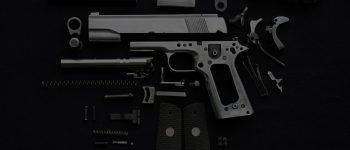Decimal Equivalents, Drills & Fits
Fractional dimensions are, quite simply, not accurate for most tasks. Therefore, decimal equivalents must be employed.
Skip Walters

Gunsmithing requires a combination of many skills for continued success. The melding of metalwork and woodwork are necessary to create a functional work of art, the classic firearm.
Fitting metal pieces together requires a familiarity with decimal equivalents if one is to achieve the desired results. The gunsmith seldom deals in fractional dimensions. Fractional dimensions are, quite simply, not accurate for most tasks. Therefore, decimal equivalents must be employed.
A decimal equivalent is the translation of size into tenths, hundredths, thousandths, ten thousandths of an inch or meter. For most applications, the inch scale is used, but metric conversions may also be employed. Usually, four decimal places are sufficient for gunsmithing purposes. For example, 1/8” = .125”, 3/32 = .09375”, 1/16 = .0625”. (1 millimeter = .0397”)
When drilling and tapping a hole to accept a machine screw, a number drill is used. Number drills are graduated in various decimal sizes ranging from 1 to 60. These are the most commonly used drill sizes in the gun shop . The number drill sizes continue from 61 to 80, but these are more commonly used by watchmakers.
Letter drills are larger than number drills and are designated “A” through “Z”. These see limited use in the gun shop and are used primarily for making tooling and devices to expedite the gunsmith work. Fractional drills have some crossover with the number and letter drills. However, fractional drills are not precise enough for most applications. IE: The letter “E” drill is .250” (1/4”) in diameter.
To better understand decimal equivalents, obtain a tap/drill chart from a drill manufacturer, precision tool supplier or industrial supply company. A Machinist’s Handbook will contain all of this information as well. Though a new handbook is expensive, an old edition will serve just as well. Mathematics and basic industry standards have not changed. Either way, a Machinist’s Handbook is a worthwhile investment.
Decimal equivalents are instrumental for calculating press fits, clearance and sliding fits for bearings, studs and pins. A sliding (or slip) fit for a .500” shaft is a hole of .5005”. A light press for the same shaft would be .4995” A stabilizing hole for the .500” shaft should have a depth of 150% of the shaft diameter. Therefore, the minimum depth into which the shaft will be inserted to achieve stability and strength should be .750”. This condition effectively eliminates the “wobble” which develops over time with poorly mated parts. The same principle holds true for threaded holes and screws. A 1/4-28 screw should have at least .375” of engagement to be stable. (.250” X 150% = .375”)
The metal parts in guns are usually fit to .001”, so micrometers and dial/electronic calipers are frequently employed. As a result, understanding decimal equivalents is necessary to achieve the precision required for the gun shop.




